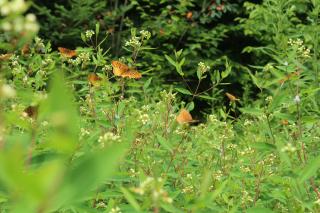Grass to gardens: Promoting pollinator pathways

VERMONT—Libraries, churches, garden clubs and more have been hosting Green Mountain & Finger Lakes National Forest staff for conversations about local solutions to a global pollinator crisis.
Staff on the forests have put together a presentation about the decline in insect populations and the pollinator pathways project. The presentations focus on the importance of pollinators and the ramifications of pollinator decline. More importantly, it emphasizes the very simple step anyone can take to help combat the crisis: converting even just a small patch of grass to garden.
“The huge decline in insect populations today is alarming,” said Stephanie Erlandson, biological science technician. “But it’s also something we can all address in our own backyards, which I think is empowering and hopeful.”
Presentations are provided locally and in person, ideally by a Forest Service employee familiar with the area. Erlandson says staff are encouraged to give the presentation and to present in their own communities when possible—building on already established relationships and promoting a neighborly conversation. So far, the team has presented to six towns.
“When it comes to addressing the pollinator decline, the best thing we can do is be a resource to our neighbors and communities,” said Erlandson. “This campaign is aimed at educating our communities about the crisis and how converting just a small bit of lawn can make a big difference.”
In addition to a presentation, the team also compiled a list of useful resources about the pollinator decline, as well as native plant lists for anyone looking to convert part of their lawn to a pollinator garden. They put the materials online for all to use and started setting up meetings wherever they could in local towns.
There are four more presentations planned, and the team is hoping to get a few more on the books as summer moves along.
